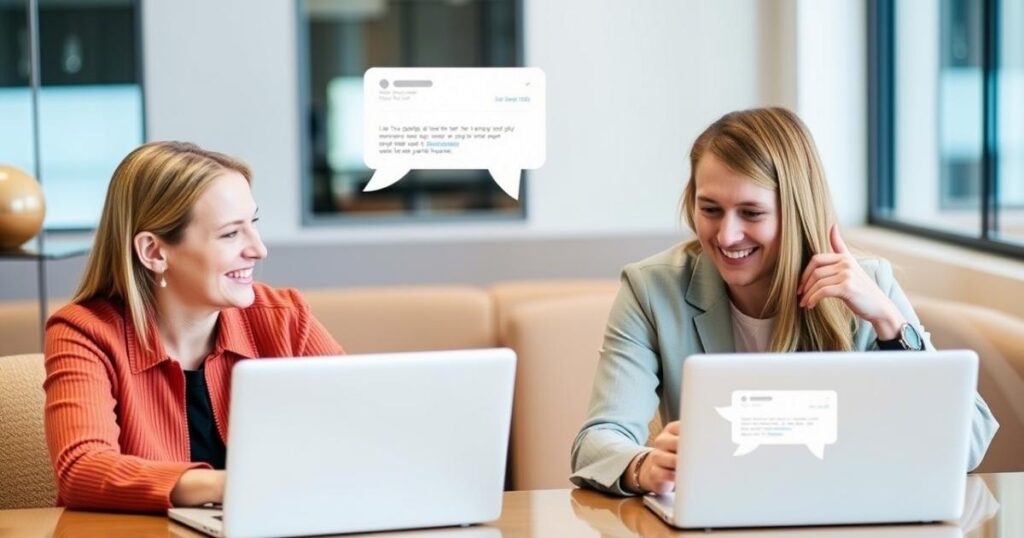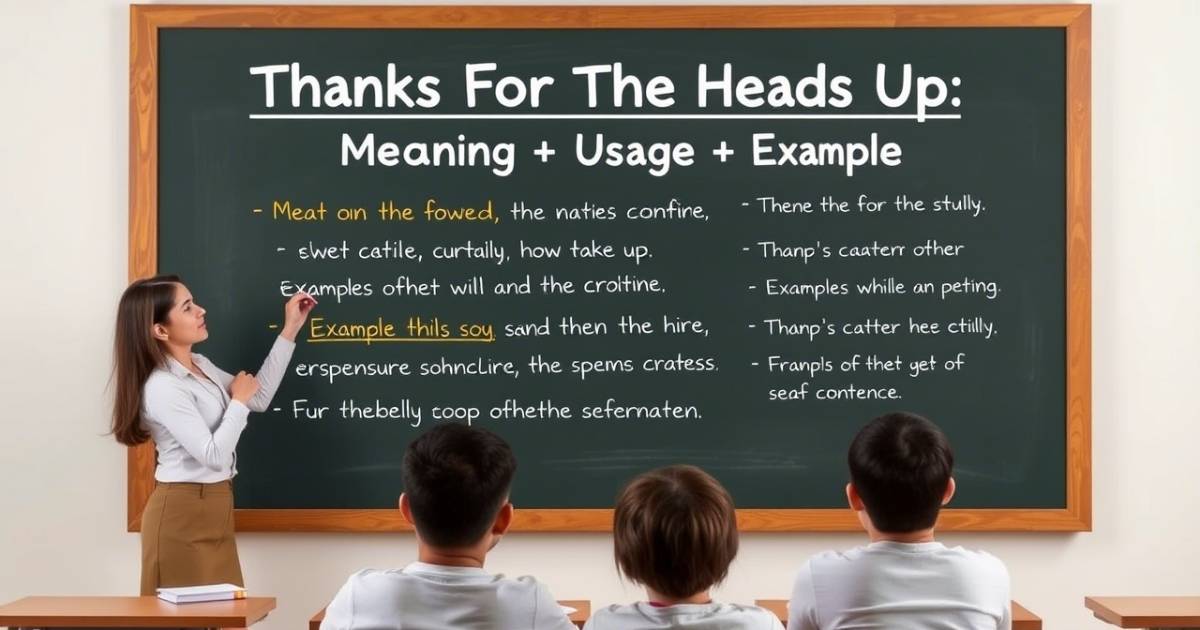“Thanks for the heads up” is a phrase we often use when someone gives us a warning or important information. It’s a polite way to show appreciation for a helpful notice. When you say “Thanks for the heads up”, you’re thanking someone for making you aware of something you might not have known. It’s a common expression in everyday conversations, especially when someone helps you avoid a potential problem or mistake.
The meaning of “thanks for the heads up” is simple. It’s all about expressing gratitude for a timely tip or piece of advice. The phrase is often used in both personal and professional settings. If someone says, “Thanks for the heads up,” they’re acknowledging that you’ve helped them by providing important information. So next time someone gives you useful advice, don’t forget to say, “Thanks for the heads up!” It’s a great way to show your appreciation for their thoughtfulness.
Understanding the Phrase
The phrase “thanks for the heads up” is commonly used to express gratitude when someone provides you with an advance warning or helpful information. In its simplest form, it’s a way of saying, “I appreciate the alert you gave me.” The term “heads up” itself refers to a notice or tip-off about something that might happen or something important to be aware of.
When someone says “thanks for the heads up”, they are acknowledging the value of being informed in advance. Whether it’s a potential problem, an opportunity, or just useful information, the phrase helps convey appreciation for the time and effort someone took to share this alert with you. It’s an expression of gratitude for the consideration of keeping you in the loop.
The phrase can be dissected into two parts:
- Thanks: A simple yet powerful expression of gratitude. It conveys appreciation for someone’s effort or action.
- Heads up: A colloquial term meaning advance notice or a warning about something that may happen. It signifies an alert or helpful information shared ahead of time.
When combined, “thanks for the heads up” becomes a way of acknowledging and expressing thanks for someone’s effort to inform you about something important, allowing you to prepare or take action in advance.
Usage in Different Contexts
“Thanks for the heads up” can be used in various contexts to show gratitude for being informed in advance. Whether it’s a colleague warning you about a busy schedule, a friend notifying you about bad weather, or a family member giving you a heads-up on an event, the phrase is a casual yet polite way to express appreciation. It shows that you value the information shared and helps you feel more prepared for what’s coming.
1. Personal Conversations
In everyday life, “Thanks for the heads up” is a handy phrase to acknowledge when someone warns or informs you about something important. It could be a friend telling you about a traffic jam on your usual route or a sibling reminding you about a family gathering. Using this phrase makes conversations feel warm and appreciative.
For example, if a friend says, “Hey, just so you know, the movie theater is packed tonight,” responding with “Thanks for the heads up” shows gratitude for the information. It’s a small yet meaningful way to recognize their effort in keeping you informed.
The phrase also works well in casual text messages or calls. A simple “Thanks for the heads up” can let the other person know that their message was received and valued. It keeps conversations friendly and engaging.
2. Professional Settings

In the workplace, “Thanks for the heads up” is often used when a colleague, manager, or client provides valuable information. This could be about a last-minute meeting, a deadline change, or an important project update. It’s a professional and courteous way to acknowledge their effort in keeping you in the loop.
For instance, if a coworker informs you, “The client wants to move the meeting to 2 PM instead of 4 PM,” responding with “Thanks for the heads up” ensures clear and positive communication. It also reinforces teamwork and a collaborative work environment.
Additionally, this phrase can be useful in emails or business messages. Writing, “Thanks for the heads up! I’ll adjust my schedule accordingly,” makes the response polite, professional, and efficient. It helps maintain smooth workplace interactions.
3. Digital Communication
In the digital world, people often use “Thanks for the heads up” in emails, text messages, and online chats. Whether it’s a social media update, an email from a colleague, or a notification from a service provider, the phrase is an easy way to acknowledge information.
For example, if a friend texts, “Your favorite online store is having a huge sale today,” replying with “Thanks for the heads up!” shows appreciation while keeping the conversation light and engaging.
Even in professional emails, the phrase can be valuable. If a coworker emails you about a policy update, responding with, “Thanks for the heads up! I’ll review the changes,” shows attentiveness and gratitude. This keeps communication clear and professional.
4. Dealing with Unforeseen Circumstances
Life is full of surprises, and sometimes, a heads-up can help us prepare for unexpected events. Whether it’s a weather warning, a sudden schedule change, or an unexpected expense, saying “Thanks for the heads up” acknowledges the person who gave you the information.
Imagine receiving a message that a flight has been delayed. Responding with “Thanks for the heads up! I’ll adjust my plans accordingly,” helps maintain a positive attitude in frustrating situations.
Even in emergencies, this phrase can be useful. If someone warns you about a power outage in your area, a simple “Thanks for the heads up” keeps the communication open and appreciative, even in stressful times.
5. Social Interactions and Networking
In social settings and networking events, being informed in advance about people or situations can be helpful. Whether it’s knowing about a new guest at a party or learning about a company’s expectations before an interview, “Thanks for the heads up” helps you acknowledge useful information.
For example, if a friend tells you, “By the way, the host at tonight’s event loves discussing tech trends,” responding with “Thanks for the heads up! I’ll keep that in mind,” shows social awareness and readiness to engage.
Networking can also involve job referrals or career advice. If a mentor informs you about a job opening, replying with “Thanks for the heads up! I’ll look into it,” demonstrates enthusiasm and appreciation. It helps build professional relationships while keeping interactions positive.
The Nuances of Tone and Context
The phrase “Thanks for the heads up” may seem simple, but its tone and meaning can change depending on the situation. How you say it whether in person, over text, or in an email affects how it’s received.
When spoken sincerely, “Thanks for the heads up” conveys genuine gratitude. It acknowledges that someone took the time to provide important information. However, when said with a sarcastic tone, it can imply annoyance or frustration. For example, if someone tells you about a deadline at the last minute, you might say, “Oh, thanks for the heads up,” with an eye roll, signaling dissatisfaction.
In professional settings, it’s best to keep the tone neutral or appreciative. Saying, “Thanks for the heads up! I’ll make the necessary adjustments,” ensures clarity and professionalism. The phrase’s flexibility makes it useful in both casual and formal conversations, but understanding tone and context is key to using it effectively.
1. Sincerity and Politeness
The phrase “Thanks for the heads up” is most effective when used with sincerity. It shows appreciation when someone shares valuable information that helps you prepare for something in advance. A genuine tone ensures the message is received positively.
For example, if a friend reminds you about a road closure on your commute, responding with, “Thanks for the heads up! I’ll take another route,” shows gratitude. In face-to-face conversations, a smile and friendly tone reinforce sincerity. In written communication, adding an exclamation point or a follow-up message can enhance warmth.
However, if delivered in a flat or dismissive manner, the phrase might come across as indifferent. Ensuring sincerity helps maintain positive relationships and shows that you value the effort someone made to inform you.
2. Professionalism
In professional settings, “Thanks for the heads up” is a useful way to acknowledge new information while maintaining a polite and respectful tone. Whether it’s a colleague informing you about a policy change or a manager updating you on a deadline, using this phrase can keep workplace communication smooth and professional.
For instance, if your supervisor says, “We have a meeting rescheduled to 2 PM,” a professional response would be, “Thanks for the heads up! I’ll be ready.” This acknowledges the update and reassures the speaker that you are prepared.
Additionally, in emails or formal messages, pairing the phrase with a follow-up can enhance clarity. For example, “Thanks for the heads up! I’ll adjust my schedule accordingly.” This confirms your understanding and response to the new information.
3. Informality and Casual Conversations
In everyday conversations, “Thanks for the heads up” is often used in a lighthearted and casual manner. Friends and family members frequently exchange small yet useful pieces of information, making this phrase common in informal settings.
For example, if a friend warns you about a long wait at a restaurant, responding with, “Oh, thanks for the heads up! I’ll get there early,” keeps the interaction easygoing. In texting and social media, it’s often used without much formality, such as “Thx for the heads up!”
The phrase also works well when discussing plans or unexpected events. If someone reminds you of an upcoming event you almost forgot, a quick “Thanks for the heads up, totally slipped my mind!” keeps the tone friendly and relaxed.
4. Addressing Potential Negativity
While “Thanks for the heads up” is generally a positive phrase, it can sometimes be used sarcastically, especially when someone shares late or inconvenient information. In these cases, the tone plays a crucial role in conveying the intended meaning.
For instance, if a colleague informs you of a last-minute task, you might respond with “Oh great, thanks for the heads up…” in a dry tone, signaling frustration. However, in professional environments, it’s best to keep responses constructive. Saying, “Thanks for the heads up. I’ll do my best to adjust,” acknowledges the situation without adding negativity.
When dealing with potentially frustrating updates, keeping the phrase neutral or pairing it with a clarifying question such as “Thanks for the heads up. Is there anything else I should know?” helps maintain professionalism while addressing concerns.
Related Guide:
Looking Forward To Seeing You: Grammar + Examples[2025]
Cultural and Regional Variations
The way people use and interpret “Thanks for the heads up” can vary depending on cultural and regional differences. While the phrase is widely understood in English-speaking countries, its tone and meaning might shift based on local communication styles and social norms.
1. American and British English
The phrase “Thanks for the heads up” is commonly used in both American and British English, but there are subtle differences in tone and usage.
In American English, the phrase is widely used in both casual and professional settings. It’s a direct and straightforward way to acknowledge useful information. Americans often use it with a friendly and appreciative tone, sometimes adding enthusiasm, such as:
“Oh, thanks for the heads up! I’ll make sure to check that out.”
In British English, the phrase is also understood, but its usage may vary slightly. Brits often favor more indirect or polite expressions, sometimes incorporating humor or sarcasm. For example:
“Thanks for the heads up much appreciated.” (Formal and polite)
“Oh, cheers for the heads up!” (Casual and friendly)
“Thanks for the heads up… I suppose that means I should be worried?” (Sarcastic British humor)
While both dialects use the phrase, Americans tend to be more direct, whereas Brits may adjust their tone based on context and social norms.
2. Formality Levels in Different Cultures
The level of formality when using “Thanks for the heads up” varies across cultures. In more informal cultures like the United States, Australia, and Canada, the phrase can be used freely in casual and workplace conversations. However, in more formal cultures, a different approach may be necessary.
For example, in Germany and Japan, professional interactions often require a more structured and respectful tone. Instead of directly saying “Thanks for the heads up,” a more formal alternative like:
“Thank you for informing me in advance.” (Germany)
“I appreciate your notice on this matter.” (Japan)
Similarly, in France, a more polished phrase like “Merci de m’avoir prévenu” (Thank you for warning me) might be preferred over the direct English equivalent.
In contrast, Scandinavian countries tend to embrace directness in communication, making “Thanks for the heads up” a phrase that can be easily used in professional and casual conversations alike.
3. Non-English Speaking Contexts
When translated into other languages, the phrase “Thanks for the heads up” may not always have a direct equivalent, requiring contextual adaptation.
In Spanish, a common equivalent is “Gracias por avisarme” (Thanks for notifying me), which conveys the same meaning.
In Mandarin Chinese, people might say “谢谢提醒” (xièxiè tíxǐng), which translates to “Thanks for the reminder” rather than a literal “heads up.”
In Russian, the phrase “Спасибо, что предупредил” (Spasibo, chto predupredil) means “Thanks for warning me,” aligning closely with the meaning of “heads up.”
Understanding how different cultures interpret and use similar expressions helps ensure effective and respectful communication in diverse settings.
Personal Experiences with the Phrase
I’ve had many moments where “Thanks for the heads up” saved me from trouble. A friend once warned me about a surprise quiz, giving me just enough time to prepare. At work, a colleague’s quick reminder about a last-minute meeting change helped me avoid embarrassment. Even in social situations, a timely heads up—like knowing my ex was at a party—spared me from awkward encounters. Whether in casual chats, professional emails, or online interactions, this phrase has always been a simple yet effective way to show appreciation for valuable warnings.
Preventing Misunderstandings
Miscommunication can create unnecessary tension. A simple “Thanks for the heads up” helps clarify things and ensures both parties are on the same page. Acknowledging someone’s warning or advice confirms that you understand their message.
In casual conversations, this phrase can prevent awkward situations. For example, if a friend tells you about an inside joke before you mistakenly take offense, thanking them shows that you appreciate their effort to keep things smooth. It reassures them that their warning was useful.
In professional settings, misunderstandings can be costly. If a colleague informs you of a potential error in your report, responding with “Thanks for the heads up” shows you value their input. It creates a positive communication flow and reduces errors.
Staying Prepared
Forewarning helps you stay ahead of potential problems. Whether it’s a change in work deadlines or unexpected weather conditions, saying “Thanks for the heads up” acknowledges valuable information that allows you to plan accordingly.
For instance, if a coworker alerts you about a sudden meeting, thanking them shows that you recognize their effort. It also helps you mentally prepare, ensuring you’re not caught off guard. Small moments like these build efficiency.
In daily life, this phrase helps you avoid unnecessary stress. If a friend warns you about heavy traffic on your route, a quick “Thanks for the heads up” encourages mindful planning. It turns minor alerts into major time-savers.
Building Trust and Relationships

Expressing gratitude strengthens connections. Saying “Thanks for the heads up” reassures others that their advice is valued, encouraging open and honest communication. Over time, this builds stronger relationships.
When people feel appreciated, they’re more likely to share helpful information. In friendships, thanking someone for warning you about a difficult person or situation shows emotional intelligence. It fosters deeper bonds and mutual respect.
In the workplace, trust is essential. Acknowledging someone’s insight, whether it’s about office politics or upcoming challenges, helps build rapport. Simple gratitude makes others feel heard, leading to a more cooperative and supportive environment.
Practical Tips for Using the Phrase
When using “Thanks for the heads up,” make it specific by adding details relevant to the situation. Adjust your tone based on the context casual for friends, professional for work. If the heads-up requires action, follow through to show genuine appreciation.
Be Specific and Personalize
Instead of a generic “Thanks for the heads up,” adding details makes your response more meaningful. For example, saying “Thanks for the heads up about the meeting delay; that gives me extra time to prepare” shows attentiveness and appreciation.
Personalizing your response also makes the conversation feel more engaging. If a friend warns you about a last-minute plan change, you might say, “Thanks for the heads up, Fiona! I’ll adjust my schedule accordingly.” Small touches like using their name create warmth.
Use Appropriate Tone and Context
Tone matters when using “Thanks for the heads up.” In casual settings, a friendly and lighthearted tone works best. Saying it with a smile or adding an emoji in digital conversations can make it more natural.
In professional environments, maintaining a neutral and appreciative tone is key. If a manager informs you about a new policy, responding with “Thanks for the heads up! I’ll review the details” keeps the interaction professional and positive.
Follow Up with Action
Acknowledging a heads-up is great, but acting on it makes it meaningful. If someone alerts you about a problem, taking steps to address it reinforces your appreciation.
For example, if a coworker informs you about a project deadline change, you might say, “Thanks for the heads up! I’ll adjust my schedule and get the revisions done on time.” This confirms that you received the message and are taking it into account.
Use Variations When Needed
Sometimes, switching up the phrase makes it sound more natural. Instead of always saying “Thanks for the heads up,” you can use variations based on the situation.
For informal chats, phrases like “Good to know!” or “Appreciate the tip!” can sound more relaxed. If you need a more formal tone, something like “I appreciate the advance notice” works well.
Different contexts call for different wording. In emails, you might write, “Thanks for bringing this to my attention” or “I appreciate the update.” Adjusting the phrase keeps communication smooth and appropriate.
Examples of Using the Phrase
You can use “Thanks for the heads up” in many situations to express gratitude. For example, in a casual setting, you might say, “Thanks for the heads up about the traffic! I’ll leave earlier.” It helps acknowledge useful information while keeping conversations friendly.
2. Personal Conversations
- Social Plans: Thanks for the heads up about the change in dinner plans, Lisa. I’ll be there at the new time.
- Family Matters: Thanks for the heads up about Dad’s early arrival. I’ll make sure to be home on time.
3. Digital Communication

- Emails & Messages: Thanks for the heads up about the deadline extension. That really helps with my schedule!
- Online Communities: Thanks for the heads up about the forum rules. I’ll make sure to follow them.
4. Networking Events
- Event Changes: Thanks for the heads up about the venue change. I’ll update my schedule accordingly.
- New Connections: Thanks for the heads up about the guest speaker. I’ll be sure to introduce myself after the talk.
FAQ’s
What does this phrase mean in everyday conversations?
It simply means showing appreciation for advance notice. Saying Thanks For The Heads Up acknowledges the effort someone made to keep you informed.
How is it used in professional settings?
In workplaces, Thanks For The Heads Up is often used to show gratitude for important updates, helping maintain clear communication and teamwork.
Can it be used in casual chats?
Absolutely! Saying Thanks For The Heads Up is a friendly way to appreciate small warnings, like changes in plans or upcoming events.
Why is tone important when using this phrase?
The meaning of Thanks For The Heads Up can change based on tone sincere when grateful, sarcastic if frustrated, so be mindful of how you say it.
Is it commonly used in digital conversations?
Yes, people frequently type Thanks For The Heads Up in emails, texts, and online chats to acknowledge helpful information shared with them.
Conclusion
Thanks for the heads up is a simple yet powerful way to show gratitude when someone shares important information. Whether in personal chats or professional emails, saying “thanks for the heads up” acknowledges the effort of keeping you informed. The phrase is widely used, and many people wonder about the thank you for the heads up meaning or the thanks for the heads up meaning in different situations. Simply put, it’s a polite way to appreciate advance notice.
Understanding the thanks for heads up meaning helps in using it correctly. If you ever receive crucial details, responding with thanks for heads up or thank you for heads up meaning shows both appreciation and acknowledgment. Whether it’s a small tip or a major alert, using “thanks for the heads up” ensures smooth communication. So next time, don’t forget to say thanks for the heads up to those who help you stay prepared!

Zion Blaze is a dedicated administrator with 5 years of experience in managing operations, optimizing workflows, and ensuring efficiency. Skilled in leadership, problem-solving, and team coordination.

